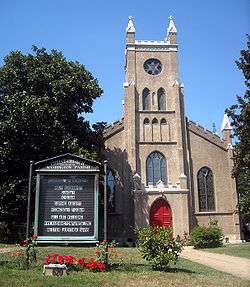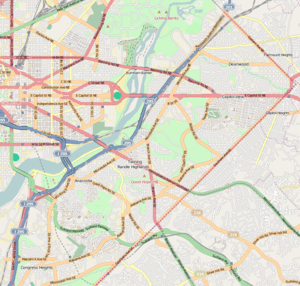Christ Church, Washington Parish
Christ Church — known also as Christ Church, Washington Parish or Christ Church on Capitol Hill — is a historic Episcopal church located at 620 G Street SE in Washington, D.C., USA.[2] The church is also called Christ Church, Navy Yard, because of its proximity to the Washington Navy Yard and the U.S. Marine Barracks nearby (such that the neighborhood is sometimes called "Barracks Row").
Christ Church | |
 Christ Church, Washington Parish | |
   | |
| Location | 620 G Street, S.E. Washington, D.C. |
|---|---|
| Coordinates | 38°52′53″N 76°59′52″W |
| Built | 1807 |
| Architect | Latrobe, Henry; Blagden, George |
| Architectural style | Gothic Revival |
| NRHP reference No. | 69000291[1] |
| Added to NRHP | May 25, 1969 |
Built in 1807 in Gothic Revival style, the church began as one of two parish churches of Washington Parish, which the Maryland General Assembly created in 1794. The current building, built after the American Civil War, was added to the National Register of Historic Places in 1969.[1]
History
Although St. Paul's Church, Rock Creek Parish was founded in 1712 and built a church in 1775 (and remains in the District of Columbia), after the United States Congress decided to establish the new nation's capitol on the Potomac River in 1790 (effective in 1800), accepting land granted for that purpose by the state of Maryland and the Commonwealth of Virginia to form the District of Columbia, that church was far from the two population centers developing on the riverfront. In 1789, Maryland's General Assembly had granted a charter to the town of Georgetown at the falls of the Potomac River near its confluence with Rock Creek, although that port development had begun in 1759. In 1792, Thomas John Claggett was consecrated as the bishop of the Diocese of Maryland in the newly re-established Episcopal Church. In the following year, he drew the diocesan convention's attention to the distance between the Rock Creek parish and the population centers developing as the national capital was being constructed, and they appointed a 12-member vestry for establishing a parish in Washington. In December, 1794, the Maryland General Assembly formally established Washington Episcopal parish nearer the developing riverfront. Two priests were appointed, Rev. George Ralph (a teacher) for the eastern portion and Rev. Edward Gantt (M.D.) for the western portion, although no record remains of either holding services. Records do show Rev. Walter Dulaney Addison traveling from his home in Oxon Hill, Maryland to conduct services, at first at the Presbyterian Church on M Street with the permission of Rev. Stephen Balch. Soon, a vestry was established, and decided to build two churches, one at either end of the new parish, reflecting the population center at Georgetown as well as near the buildings being constructed for the capital, on the parish's eastern part.[3] They started raising subscriptions and held lotteries to raise funds to construct the buildings, but fundraising proved slow for each of the proposed churches, and construction stopped on the Georgetown church in 1797 with its walls half up.
After disestablishment, pew rentals generally provided the parish's chief source of income. President Thomas Jefferson was a subscriber to this church, as he had for the earlier-constructed Presbyterian church, and he regularly attended services at the old tobacco warehouse church where services were held until 1807, when the present site near the Navy Yard was donated by William Prout.
Finally, on successive days in 1809, bishop Claggett consecrated the two buildings used by the parish: Christ Church on the eastern portion and what was originally known as St. John's Church in Georgetown to the west (but which later became known as Christ Church Georgetown). Three free pews were regularly reserved: one for the President of the United States; one for the donor of the land, Mr. Prout; and one for the Rector's family. When the first service was held at the new site on August 9, 1807, the church was known only as the "New Church in the Navy Yard." The U.S. Marines billeted at their nearby barracks also used the church in the early days. The vestry formally adopted the name "Christ Church" on August 20, 1807.
Several early U.S. Presidents (Madison, Monroe, etc.) worshiped there. Rev. Ethan Allen was the longest serving rector in the church's early years, and helped build the church's first rectory, completed in 1824. The parish also acquired a burial ground to the east, which became Congressional Cemetery, which is the unofficial resting place for members of Congress. One of Christ Church's somewhat more recent members was John Philip Sousa, the celebrated bandmaster and march composer who lived on the same residential block. Sousa was married at Christ Church and buried in Congressional Cemetery.
Architecture
Although there is some controversy, Benjamin Latrobe, one of 19th-century America's greatest architects, is generally credited with the design of the present church building. It was constructed of brick in the Federal style, which was evolving into the Gothic revival style.
The bell tower, added in 1849, was used as an observation post during the Civil War. The present Parish Hall was built in 1874. In 1924, the first rectory was razed and the present one was built on the same site. The Crucifixion window at the end of the chancel, a memorial to mothers, dates from 1927. In 1966, a two-story addition to the Parish Hall was constructed and dedicated to the memory of Rev. Edward Gabler, the priest and rector from 1928 to 1944.
References
- "National Register Information System". National Register of Historic Places. National Park Service. April 15, 2008.
- Taylor, Nancy C. (1969). "Christ Church, Washington Parish". National Register of Historic Places Nomination Form. National Park Service. Retrieved December 19, 2013.
- Frances Barbour Lumbard, The Changing Face of St. John's: 200 Years in Georgetown (Washington D.C. 1998) at pp. 15-40
This article contains information that originally came from US Government publications and websites and is in the public domain.
External links
| Wikimedia Commons has media related to Christ Church (Washington, D.C.). |
- Official website

- Christ Church Washington Parish History at the Wayback Machine (archived October 28, 2007)
- NPS webpage on Christ Church